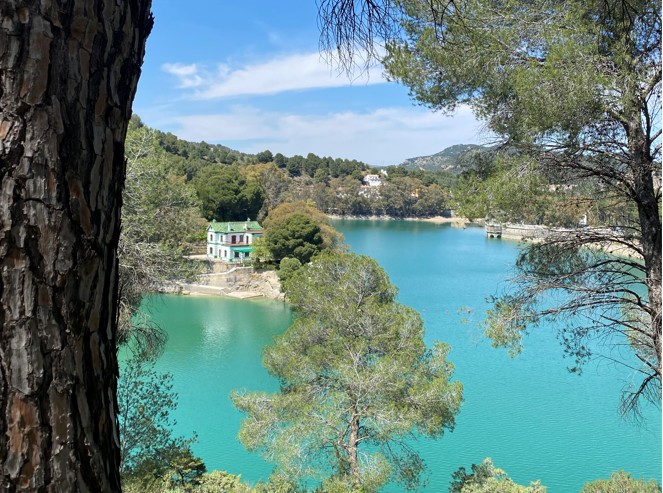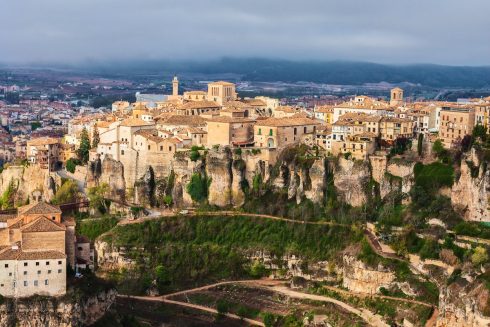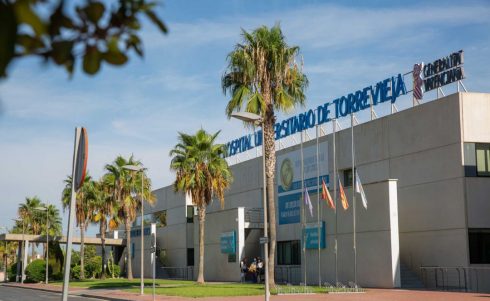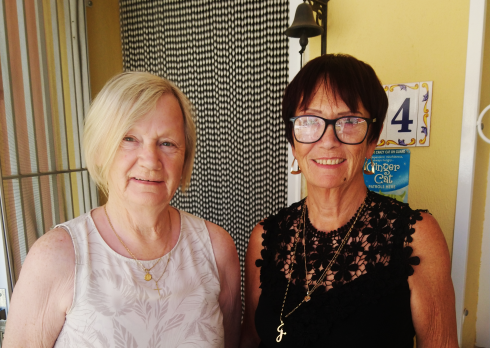KNEES knocking and nerves jangling many a thrillseeker has navigated their way along the death-defying Caminito del Rey, before taking a dip (or jump) into one of the trio of stunning turquoise lakes nearby.
It had long been dubbed the ‘world’s deadliest walkway’ (understandably with no handrail and big sections missing) until the Caminito reopened seven years ago following a €3 million upgrade.




But you’ll still need a head for heights taking this high-adrenalin hike that runs through the El Chorro gorge, an immense fissure five kilometres long and 300 metres deep as it slices through towering limestone cliffs.
Set between the two postage stamp-sized villages of Ardales and El Chorro, it is no wonder this area garnered the nickname ‘the Andalucian Lake District’, in part thanks to a series of Olive Press travel articles over a decade ago.
The scenery is more akin to the countryside of Cumbria or the cantons of Switzerland than the average scenery on the Costa del Sol with the two villages linked by hairpin bend roads past the shimmering reservoirs bordered by sandy beaches and shaded by feathery conifers.




With lakeside campsites, it’s the quintessential active weekend break for outdoor sports types, offering rock climbing, watersports, pedalos and dining under the stars at charming pine-shaded ventas.
There is a lot to explore, with one incredibly interesting side trip up to the ancient ruined city of Bobastro, found by taking a side road uphill just a few clicks outside El Chorro.
A fascinating place, it was here in the ninth century that rebel Muslim leader Omar Ibn Hafsun, declared independence from the Moorish kingdom of Cordoba, leading to decades of conflict and the setting up of an impregnable mountain redoubt that was hard to capture and even harder to find.
Today, you can explore the site, with its various buildings and ruins that suddenly emerge in clearings amid deep woodland. Most fascinating of all is an ancient church that was literally hewn out of rock, with circular shapes as windows, one presumes.

This is all part of the upper reaches of the Guadalhorce Valley, but is merely the icing on the cake of a region that has been an expat favourite to settle for decades.
Reached via Malaga inland towards Alhaurin or from Fuengirola going basically uphill, the best way to arrive is from Marbella on the Coin road, via the white-washed pueblos of Ojen, Guaro and Monda with its impressive hilltop castle and stunning nearby gorge.

Once a best-kept secret, thousands of new visitors are discovering this lesser-known valley thanks to the El Chorro Challenge.
The polar opposite to the glitz and glamour of the nearby coast, which is just 20 to 30 minutes away, the valley offers a more peaceful, relaxed way of life.
Largely rural, the lifestyle here is much more typically Spanish than the nearby resorts.
Coin, the region’s ‘capital’ and largest town, is merely an up-scale version of its smaller neighbours (Tolox, Yunquera and Alozaina) with two main squares, an emblematic church at its centre and a multitude of winding cobbled streets full of white-washed houses.
Set up by the Romans, who made it into a market town before largely abandoning it for almost 500 years, it was then brought back to life by the Moors, who rebuilt it in 950 AD.
Much of this later success came from the quarries of marble and iron ore which were used in the construction of Sevilla’s famous settlement of Italica, the birthplace of the future Emperor, Hadrian.
Reconquered by the Christians during a long siege in which Christopher Columbus allegedly took part, it was also popular with another great explorer Captain Cook, who visited in 1829.


After a visit to Cartama, Alhaurin and Coin, he wrote, ‘These villages are on rising ground above the river and in beauty of situation and cultivation cannot be excelled.
“They afford a specimen of the whole country when possessed by the Moors, being surrounded by gardens with orange, lemon and palm trees and abounding in all the fine as well as the more common fruits.”
Even today, the Guadalhorce Valley is considered to be among the most fertile in all Spain.
Crisscrossed with streams, as well as modern and ancient acequias (man-made water channels), it has as much modern cultivation as it has wildlife, while signs of its fecundity are found in the villages where you can pick oranges and lemons that line the streets.
To the west of the valley, the soaring Sierra de las Nieves has seen even less human interference, leading to it being recently declared a National Park, Andalucia’s third, after Donana and the Sierra Nevada.
Apart from the few towns and villages on its outskirts, the park is largely uninhabited, with a rich variety of pine, fir, ash, chestnut and oak trees, and countless streams and waterfalls.
A National Hunting Reserve teeming with mountain goats and mouflon deer, rambling, horse riding and river kayaking are all great ways to explore its undiscovered beauty.
The park is easily accessible from the picturesque villages of Tolox and Yunquera, which possess a charm all of their own.
Tolox is a tumble of white-washed houses where the villagers have even gone so far as painting the tree trunks white, to reinforce the pueblo blanco look.

Yunquera is slightly bigger, with one of the most picturesque church spires in the Guadalhorce Valley although its emblem is the ancient castle towering 500 metres above the village.
One of the highest points in Malaga province, El Castillo is believed to have been built by the Arabs and used as a watchtower during wars. Today this important heritage site has been refurbished to function as an information centre for the Sierra de las Nieves.
Just 15 minutes from Yunquera, Alozaina is embedded like a jewel in a setting of olive groves.
The entrance to the village’s charming centre is marked by stone arches while the church – the crowning glory in most of these pueblos – can be seen against the skyline from the narrow streets below.
From the striking Santa Ana church itself, there are spectacular views towards the Sierra Prieta.
A half an hour north east you cannot miss Alora, which can be seen from miles around.
This stunning place packed with Moroccan and Roman influences is topped by a castle, which sits on a lofty pinnacle looking down on this quaint pueblo.
A stop at the 17th century La Encarnacion church en route is the perfect prelude to the main event atop Cerro de las Torres hill.
The castle has had a long and chequered history. Originally built by Phoenicians, before being expanded under Roman rule, it was destroyed by the Visigoths and rebuilt by the Moors.
Last, but not least, as you head back down to the coast it is likely you will head past Cartama, with a castle of its own looking down from high above.
But Cartama, while an attractive place to while away a morning, is now becoming known for something far more international: its famous annual cricket tournament.
This small white town is now home to the Cartama Oval and the recently inaugurated European Cricket Championships, which kicks off again in February.
The 2022 Bet2Ball European Cricket League (ECL22) finals will take place over six weeks from February.
Dubbed as ‘the Champions League of European cricket’, ECL22 is a 30-team tournament including the champions of England, Ireland and Scotland, as well as teams from the likes of Jersey, Austria, Hungary and Switzerland.
READ ALSO:
- WHERE TO STAY: The best rural retreats in Spain’s Guadalhorce Valley
- Where to eat: Enjoy the amazing local produce in Spain’s Guadalhorce Valley
Click here to read more News from The Olive Press.








